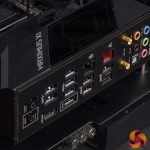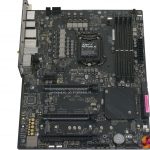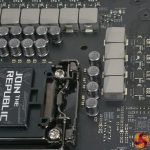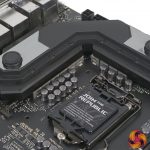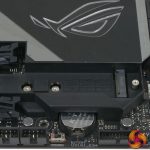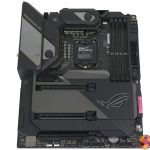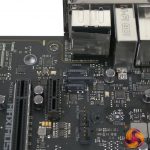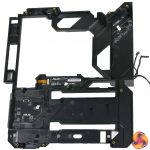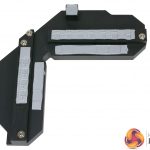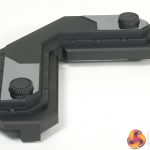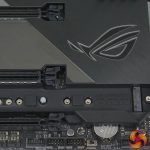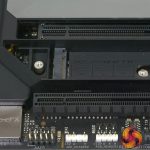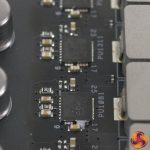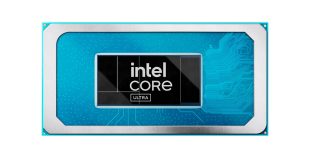Note: if the above images are not displaying properly, you may need to disable your Ad Blocker as they are known to interfere with our display code
Asus has included an extensive list of features on the ROG Maximus XI Formula including Aquantia AQC111SC 5 Gigabit LAN, in addition to Intel Gigabit and Intel Wireless-AC 9560.
Visually, the main features of Asus ROG Maximus XI Formula are the extensive armour that covers a large part of the board, the huge integrated I/O shield and the CrossChill EK III VRM hybrid cooling block on the VRMs. The colour scheme is an understated grey and matt black, although you get a muted RGB light show when you turn the power on.
Asus has made the sensible decision to ‘only’ configure the Formula with two graphics slots, which leaves the lower half of the board looking somewhat empty. The reason this is a sensible decision is that Intel desktop processors only provide sufficient PCIe Gen.3 for x16 or x8+8 lanes, and we know that most people build their PC using a single graphics card.
Below the second graphics slot you will find the heat shield/cover for the two M.2 slots which, naturally, is intended for bare SSDs that are supplied without their own heat spreader.
As we discuss in our video, there are a great many headers and connectors around the edges of the board and we saw nothing that gave us pause for thought. Some of the exclusive ROG features such as the Node connector or the water flow connector are fairly unnecessary but there are no problems with the layout and everything fits in well.
We particularly liked the inclusion of two pairs of RGB connectors (both 12V and ARGB) with one pair down near the audio connector and the other at the top of the board.
We stripped the board down and once we had removed the CrossChill EK III VRM cooling hardware we could see the VRM controller is marked ASP1400CTB, which might be a Richtek part. The ten power phases you can see are arranged in an 8+2 configuration but unusually the eight Vcore phases are not doubled but instead use control phases so the eight phases work in four pairs.
The MOSFETs are Vishay DrMOS SiC639 that are rated at 50A, so the board is capable of delivery all the power your Core i9-9900K might require (it would make no sense to install a lesser CPU such as a Core i7 or Core i5 in this premium motherboard) but even so, the 8+4 EPS connectors are unnecessary as the 8-pin will do a perfectly decent job on its own.
 KitGuru KitGuru.net – Tech News | Hardware News | Hardware Reviews | IOS | Mobile | Gaming | Graphics Cards
KitGuru KitGuru.net – Tech News | Hardware News | Hardware Reviews | IOS | Mobile | Gaming | Graphics Cards


